Our Lady of Porta Vaga
| Our Lady of Solitude of Porta Vaga Nuestra Señora de la Soledad de Porta Vaga Birhen ng Soledad ng Porta Vaga | |||||
|---|---|---|---|---|---|
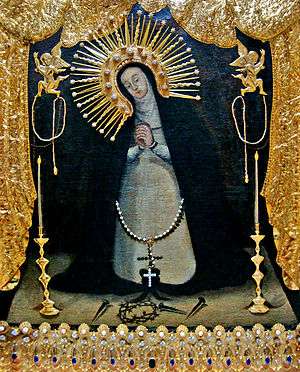 Original bejeweled painting of the image.
| |||||
| Light of the Philippines, Celestial Guardian, Protector, Exalted Patroness, Queen of Cavite Province and its port | |||||
| Venerated in |
Roman Catholic Church Philippine Independent Church | ||||
| Major shrine |
San Roque Church, Cavite City, | ||||
| Feast | 2nd and 3rd Sunday of November | ||||
| Attributes |
Oil painting on canvas Aureola with 24 stars made from diamonds Rosary, beads made from pearls and the Cross of diamonds, The Crown of Thorns and Nails symbols of Christ's Passion gold and silver Riza in the shape of candle sticks, angels, curtains, and shells Silver and Kamagong Frame | ||||
| Patronage | Province of Cavite, Cavite City Patroness of Galleons, Seafarers, Caviteño people | ||||
Our Lady of Solitude of Porta Vaga (Spanish: Nuestra Señora de la Soledad de Porta Vaga), or commonly Our Lady of Porta Vaga, is a Marian title associated with a religious icon which depicts the Virgin Mary as Our Lady of Solitude.
The venerated image is permanently enshrined in San Roque Church in Cavite City as its patroness. [1] On 19 March 2018, Pope Francis officially granted a Papal Bull for the Canonical coronation of the venerated image.
History
Traditional legend claims that during the Spanish colonial era, at the peak of Cavite's economic prosperity because of the Manila-Acapulco Galleon Trade, a small detachment of the Spanish Guardia Civil was stationed at a garita (little garrison, or sentry post) located at the Vaga Gate of the Cavite Port, at the end of the isthmus separating it from Barrio San Roque.
One stormy night, a Spanish sentinel was at his post when he saw a bright, shifting light. A dazzling apparition rose from the currents of Cañacao Bay and startled the sentry, who surmised that the light came from pirates out to raid the port.
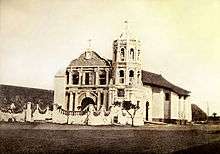
A marian apparition of the icon is retold per oral tradition. The following morning, fisherman and workers at the Cavite Royal Arsenal passed through the Vaga Gate and found a framed image of the Virgin on the beach along Cañacao Bay, near the place of her apparition the night before. They brought the painting to the parish priest, who temporarily installed it in the parish church. Eventually, the Ermita de Porta Vaga (Chapel of Vaga Gate) was built along the port's walls, and for three centuries served as the shrine of Our Lady of Solitude.
In 1892, celebrated Philippine composer Julian Felipe penned the hymn "Reina de Cavite" on the occasion of her fiesta and the opening of the Exposición Regionál Caviteña (English: Cavite Regional Exposition). The lyrics were taken from the poem Himno a la Virgén de Cavite (Hymn to the Virgin of Cavite) by Fr. Tomás de Andrade, S.J., the rector of the Jesuit College of Cavite sometime in 1689.[2][3]
In 1929, a new parish priest, Fr. Pedro Lerena y Lerena of Logroño, Spain, was assigned to the Cavite Port. At the same time, he was appointed Rector of the Ermita. His great dedication to the cause of Our Lady of Porta Vaga saw the beautification and the improvement of the Ermita through the years.
During the Second World War, Fr. Lerena rescued the icon from a junkyard that the Imperial Japanese Army had thrown it in. The image first stayed in the Arzobispado (Archbishop's Palace) in Intramuros before it was deposited in the vaults of the Philippine National Bank for safekeeping.
The icon returned to Cavite after the Allied liberation of the islands in 1945, re-enshrined at its home in the San Roque Church because the Ermita was destroyed by bombardment during the war. Fr. Lerena served as the icon's guardian until his death in 1972.
On 30 August 2017, the image was nominated as national cultural treasure by the Cultural Properties Regulation Division of the National Museum of Fine Arts of Manila.
Theft and return
On 16 March 1984, the icon of the Virgin was stolen from its altar and was recovered on 15 August 1984, albeit stripped of all its original gilding and precious stones. The devotees tasked themselves to restore the image to its former glory and was re-enshrined in the altar on 19 August 1984.[4]
Titles
The icon is known in its province as the "Queen of the City of Cavite" and "Exalted Patroness and the Celestial Guardian and Protectress of the City of Cavite and its Port" (Spanish: "Reina de la Ciudad de Cavite", "La Excelsa Patrona y La Celestial Guardiana y Protectora de la Ciudad de Cavite y su Puerto").
The icon was used to bless departing trade galleons plying the route between Cavite and Acapulco, Mexico, earning her the title "Patroness of the Galleons", while claims of miracles associated the icon as "The Virgin of a Thousand Miracles".
Description
The Blessed Virgin Mary is depicted as garbed in black and white, kneeling as she contemplates the instruments of her Son's Passion. Before her are the crown of thorns and the nails.[5] The icon is painted on canvas and framed in carved wood. The painting itself is set in gold and silver accouterments studded with precious gems that are ex votos from devotees. It is considered an invaluable treasure inherited by the Caviteños, and is the oldest extant dated Marian painting in the Philippines.
An inscription on the reverse of the icon reads:
Castillian: "A 12 de abril 1692 años, Juan Oliba puso esta Santissima Ymagen Haqui"
(English: "On 12 of April 1692, Juan Oliba placed this most holy image here.")
Confraternity
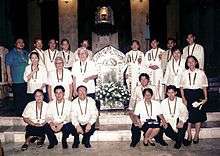
On 10 August 1998, Imus Bishop, Most Reverend Manuel C. Sobrevinias founded the Cofradia de la Virgen de la Soledad de Porta Vaga. The group was officially inaugurated on 17 November 1998 on the 20th Anniversary of the image's coronation by former Apostolic Nuncio, Bruno Torpigliani. It was led by the late Antonio G. Nazareno as its founding president, Reverend Virgilio Saenz Mendoza as its Spiritual Director and Reverend John Brillantes as its Spiritual Advisor. Reverend Virgilio Saenz Mendoza and Jonnell Ryan I. Enriquez presently lead the devotees of the confraternity.
Miraculous claims
Fire of 1830
In 1830, a fire caused by lightning bolt hit the wooden altar of the Ermita and razed the chapel to the ground, but the image of the Virgin remained intact among the ashes.
Typhoon of 1856
In 1856, a typhoon flooded the houses, churches and public buildings within the Port but the Ermita, as well as its patio were found dry so the people took refuge in the Church.
Spanish warship of 1857
On 30 June 1857, a Spanish frigate named “Lucero” was caught by a violent typhoon off the coast of Albay to Rawis, Legaspi. For twenty two days, the ship was unable to move not only because of the low tide, but also because of the absence of even a slight breeze. The crewmen were worried because their provision was running low. It happened that one of the crew members was a devotee of the Virgen de la Soledad. He took out Her picture and asked his fellow sailors to pray before Her. One night, the Virgin appeared before the crewmen in the light of the pale moon. As they fell to their knees, the tide rose higher and higher and the wind began to blow. The frigate floated free from its rocky trap and was able to return safely to Cavite. As the crewmen set foot on the ground, they proceeded right away to the Ermita. There, to the tune of the Te Deum, they expressed their gratitude and credited their safety to the image.
Cholera epidemic of 1882
In 1882, a cholera epidemic spread throughout Cavite Port, as funeral processions became a daily occurrence. The Spanish military governor of Cavite, Don Juan Salcedo y Mantilla de los Ríos, ordered the burning of gunpowder on the streets so that the fire and the smoke might drive away the disease. By mid-October, the epidemic was placed under control.
During this epidemic, the governor himself fell ill. One afternoon, as he was about to take his siesta nap, he ordered his soldiers not to admit any visitor. After some time, he heard a persistent knocking at the door, and to his surprise, he found an old woman dressed in black. After the customary greetings, she asked him to give orders that the year's fiesta be celebrated with the greatest pomp possible. Eager to send the crone on her way, Salcedo agreed to her request. The black-clad woman left, and the Governor reprimanded his soldiers for allowing her in. The guards replied that they had not done so. The Governor, upon remembering the request, realized that his strange visitor must have been the Virgin Herself, and that his fever had gone after he had spoken to her. All these miracles were depicted on large canvasses painted by Don Román Faustino, Cavite’s most celebrated painter and pupil of Juan Luna. These paintings were complete with the details and the respective dates of the miracles. Once, they were hung on the walls of the Ermita, later destroyed during World War II.
Canonical coronation
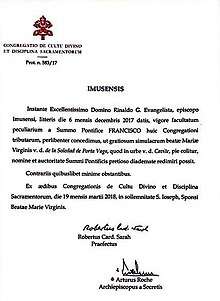
Through the joint efforts of Monsignor Baraquiel Mojica and Bishop Felix Pérez of the Diocese of Imus, the icon was ceremoniously crowned on 17 November 1978 by former Apostolic Nuncio to the Philippines, Bruno Torpigliani, D.D. The existence of a papal bull for the coronation has long been disputed as illegitimate, as no records of Pontifical authorization to crown the image previously existed in Rome.
On 19 March 2018, Pope Francis officially granted a decree of Canonical coronation towards the venerated image, while its actual date of coronation is yet pending.
Devotions and Novena
The Marian image is celebrated every second and third Sunday of November in Cavite. An annual Lenten rites and the All Saints-All Souls Day observances where she is alluded to in Tagalog as "Ináng Mágkakandila" (Mother Candlemaker). The image celebrated the Pearl Jubilee of its coronation 2008 and the Silver Jubilee of its return the following year. Devotees include Overseas Filipino Workers and other foreign nationals who flock to the country to join the Porta Vaga Festival.
Replicas of the Ynang Nag-Iisa ("Ináng Nag-iisá" in modern Tagalog), are also venerated in San Isidro, Nueva Ecija; Camba in Tondo, Manila; San Carlos, Pangasinan and Buhi, Camarines Sur.
Gallery
- The Nuestra Señora de la Soledad of San Isidro Labrador Parish Church in San Isidro, Nueva Ecija
 Nuestra Señora de la Soledad de Manila, Camba, Tondo, Manila
Nuestra Señora de la Soledad de Manila, Camba, Tondo, Manila Soledad of Buhi, Camarines Sur
Soledad of Buhi, Camarines Sur The original image in its altar frame during on its feast day.
The original image in its altar frame during on its feast day.- The icon enshrined in a silver frame, adorned with a silver mantle cape.
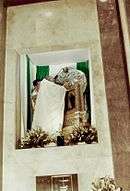 Former Apostolic Nuncio to the Philippines, Bruno Torpigliani crowning the image in 1978.
Former Apostolic Nuncio to the Philippines, Bruno Torpigliani crowning the image in 1978.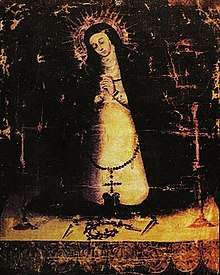 The condition of the Marian image after it was stolen. Later, it was restored to its present condition.
The condition of the Marian image after it was stolen. Later, it was restored to its present condition.
A replica copy of the Virgen de la Soledad is venerated at the chapel of “Tahanan ng Mabuting Pastol”, the Diocesan Seminary for Cavite. This image was formerly hung at the Jesuit College of Cavite. After the expulsion of the Jesuits in 1768, the image was kept in the Jesuit archives of Ateneo. The image was given to Bishop Perez as a gift on the occasion of the inauguration of the new seminary. On this replica image, an inscription says that the Spanish Archbishop of Manila, Don Basilio Sancho de Sta. Justa y Rufina granted 80 days plenary indulgence for those who would say the novena. Bishop Mateo Rubio de Arevalo of Cebu granted 40 more days along with Archbishop Don Juan Antonio de Obrigo y Gallego granted indulgence just the same.
The origin of the novena for the icon and its purported author is unknown. According to local historians, some of its prayers may have been taken from a little booklet published in 1742 entitled “Soledad patrocinante de Maria. Oracion evangelica de Nuestra Señora de la Soledad, appelida de la Puerta Vaga” (English: Under the patronage of the Mary of Solitude, with the prayers of propagation of Our Lady of Solitude, under the name of the Open Gate); a printing of a prayer or discourse book preached in 1741 by the Dominican Father Juan de la Cruz, an early local historian of his order and a Christian missionary in China.

In the 19th century, a Tagalog translation of this Novena was made by Father Juan Dilag, a chaplain of the Ermita. On 31 August 1861, the chancellor of the Archdiocese of Manila, Don Candido Ureta de Manzares approved the Tagalog translation with the following decree:
We attach herewith to act as license to print in the Tagalog language manuscript entitled ‘Pagsisiyam sa mapagpalang Ina, na ang pamagat Nuestra Senora de la Soledad.’ (English: Novena to the Blessed Mother, under the title of Our Lady of Solitude), in response to that as reported by the Censor that our Order has examined such, not contain anything against the dogma and morality, but rather deemed highly desirable for the pious reading of the faithful. Recorded for the Secretariat in testimony of this decree and filed the original subject.
— Archbishop Gregory
On Good Friday, devotees of the image come out mostly clad in black, barefoot and silently praying with their candles in hand, accompany the age-old icon on a short route to symbolize the Virgin's lonely walk back home after bringing Christ's body to the Holy Sepulchre as an act of pious mourning.
| Wikimedia Commons has media related to Our Lady of Porta Vaga. |
See also
References
- ↑ Aluit, Alphonso J. (1969). "The Galleon Guide to Philippine Festivals", p. 97. SIN B004CWODBO.
- ↑ Romanillos, Emmanuel Luis A. (2006). "Chabacano studies: essays on Cavite's Chabacano language and literature", pg. 125. Cavite Historical Society.
- ↑ Delos Reyes, Aloma Monte (1994). "Sto. Niǹo de Molino Bacoor, Canite 1984-1994: the making of a parish", pg. 139. Parish of Sto. Nino de Molino, Bacoor, Cavite.
- ↑ Mendoza, Fr. Virgilio (2002). Cavite: Cultura E Historia (First ed.).
On August 19, 1984, the celebration of the feast of San Roque was coincided with the blessing of the replica of the Virgen de la Soledad. Secretly, it was also the day set for the announcement of the recovery of the Virgin. At nine in the morning, the mass for the solemn blessing of the replica started. After the gospel, the Bishop of Imus blessed the new image. Then to the great surprise of the faithful, the stolen image was presented to them, divested of its former glory.
- ↑ Panlilio, Erlinda Enriquez (2003). "Consuming passions: Philippine collectibles", pg. 70. Jaime C. Laya. ISBN 9712714004.
Other references
- Barcelona, Mary Anne. Ynang Maria: A Celebration of the Blessed Virgin Mary in the Philippines. Edited by Consuelo B. Estepa, P.D. Pasig City: Anvil Publishing, Inc., 2004.
- Cavite Studies Center-De La Salle University Dasmariñas. CAVITE Cultura e Historia. Edited by Teresita P. Unabia and Victor Immanuel R. Cuarto. Cavite: Cavite Historical Society, Inc., 2002.
- Almanaque de N.S. del rosario, 1946, p. 284.
- Archdiocesan Archives of Manila: (Document Nos. 92 LGE1C9 1751-1752A; 109-10, LGE 1010 1767-1771; 182, LGE 1 C 8 - 1750 1742 A; 250, LGE 1 C 9 - 1747 1756; 294, LGE 1 C 9 - 1751-1752 A; 321, LGE 1 C 8 - 1737 1742; 436, Libro del Govierno Ecclesiastico 1 C 8 1737 - 1750; SV4A1 1805 - 1806 A; 475, 522, 960 LGE 1010 1767 - 1771; and 20 S V 4aL 1786 - 87 B)
- Avellanedad, Miguel. Catologo de Los Religiosos de la Orden Agustinos Recoletos, 1606-1636.
- Don Gervacio Pangilinan. Historica de Cavite, mss.
- Aviado, Lutgarda. Madona of the Philippines. [n.imp.]
- Braganza, Jose Vicente, SVD. Early Church History of Cavite: Dominicans, Recoletos and Filipino Secular Clergy. DIWA Studies in Philosophy and Theology. Vol. VIII No. 1, Tagaytay City: Graduate School of Divine Word Seminary.
- Jose, Regalado Trota, The Eight Churches of Cavite Puerto (1586-1900). Philippine Quarterly of culture and Society. 1987.
- Fernandez, Antonio J., Algunos Milagros Hechos Por Nuestra Señora, La Virgen de la Soledad de Porta Vaga- Patronas del Pueblo de Cavite. Programas de las Fiestas Generales de Cavite, 1932, pp. 11–15.
- German, Alfredo, Our Lady of Solitude: Facts and Legend". Souvenir Program Cavite Fiesta, 1964.
- Nuestra Señora de la Soledad: The Mystical Madonna of Camba. The Manila Digest, Vol. 2, No.3, Manila: Archdiocese of Manila, April 1990. pp. 11–12.
- Samonte, Godofredo, Odyssey of the Virgin. Souvenir Program Cavite Fiesta, 1964.
- San Agustin, Narciso La Tradicional Fiesta de Cavite. Souvenir Program, Cavite Fiesta, 1949.
